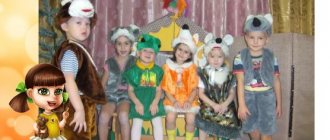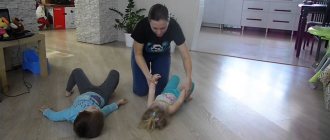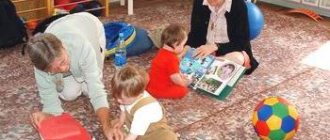Junior group. Early childhood, nursery. Children 1-4 years old
Club for an early age group (1.5 years – 3 years) “Our hands are dancing” Explanatory note. In early preschool age, great attention is paid to fine motor skills. circle work plan reflects the content for the development of fine motor skills. Finger games are very emotional and exciting. They contribute to the development of speech, creative activity...
Presentation of an additional general developmental program for children 3–4 years old “According to a fairy tale - without danger” Theater is a huge, beautiful and multifaceted world in which a child rejoices, plays, imagines and learns about the surrounding reality . One of the main problems in working with children 3-4 years old is disturbances in the development of speech and sound pronunciation. One of the effective ways...
“My World” program (club work) for children of the first junior group
Author-compiler:
Zakharova Tatyana Vladimirovna
teacher
MAUDO"Kindergarten No. 10" of the city of Yalutorovsk
Program for the course “My World”
(cognitive development for children of the first junior group)
Explanatory note
A child is born and immediately finds himself surrounded by close people who love, protect, and care for him. From the parents, the child receives the first ideas and knowledge about nearby objects and phenomena of the surrounding world. Everything that surrounds the child is of great interest.
But modern parents prefer to obtain information themselves, not from reference books and books, but from the Internet. Very often, young children spend a lot of time on a computer, phone or tablet. They watch cartoons and play educational games. But they lack the communication of adults and peers, their speech is underdeveloped, and they have no interest in the world around them.
This school year I recruited a group of children aged 2 years. I noticed that children are inquisitive, curious, they want to know and study everything. But due to their age, they do not know how to play or communicate.
I was faced with a question: how to introduce children to the world around them, teach them to see its diversity, show relationships? I developed a program for the circle work course “My World”.
The program includes:
— Games for the development of cognitive activity;
-Vocab enrichment games;
-Games for the development of motor activity;
-Games for speech development;
— Tasks for the development of memory, thinking, attention, fine motor skills;
-Looking at illustrations;
-Story games.
To determine the level of mastery of the program, diagnostics will be carried out. Circle work will be held once a week for ten minutes.
Tasks:
1. To develop children’s ability to perform tasks and exercises to strengthen the articulatory apparatus. 2.Practise the ability to compose a short, coherent story based on a picture or a work.
3. Exercise children in the ability to answer questions in complete sentences.
4. Develop skills in memorizing a short work, telling it loudly and expressively.
5.Enrich children's vocabulary.
Goal: To introduce children to objects and phenomena of the world around them, to see its diversity.
Long-term plan for circle work “My World”
| № | date | Tasks | Techniques |
| 1. | "Toys" To form knowledge about surrounding objects-toys, to develop knowledge about the color, shape, size of the toy, its purpose. | Didactic game “Wonderful bag” | |
| 2. | "Our group" Develop children's knowledge about the group's premises, their names and purposes. | Tour of the kindergarten group. | |
| 3. | "Loud quiet" Develop the ability to change the strength of your voice: speak loudly or quietly. | Didactic game “Loud-quiet” (T.V. Galantova “Educational games with children under three years old” p. 30) | |
| 4. | "Vegetables" To develop knowledge about vegetables, taste, and cooking capabilities. | Examination of vegetables (cucumber, tomato, onion, potato, carrot). Didactic game “What grows in the garden” (Card index of games for children of the first junior group) | |
| 5. | "Autumn" To form in children knowledge about the season - autumn, about seasonal changes in nature. | Game for attention “Sun or rain?” (T.V. Galantova “Educational games with children under three years old” p. 22) | |
| 6. | “What grows in the forest?” To develop children's knowledge about the flora of the forest. | Game – journey “Walk in the forest” | |
| 7. | "Different Sounds" To form children's knowledge of sounds of different volumes that can be heard in the environment, to develop attention. | Exercise “loud and quiet” (T.V. Bashaeva “Development of perception in children” p. 131) | |
| 8. | "Learning colors" Exercise children in the ability to distinguish primary colors and select objects by color. | Didactic game “Collect drops in a glass” (T.V. Bashaeva “Development of perception in children” p. 36) | |
| 9. | "Autumn Leaves" To form knowledge about the season - autumn, to expand knowledge about seasonal changes in nature. | Examination of autumn leaves, didactic games “Falling Leaves”, “Let’s Collect Leaves in a Basket” | |
| 10. | "I am human" Exercise children in the ability to distinguish and name parts of the body | Exercise “Hide and Seek” (T.V. Galantova “Educational games with children under three years old” p. 75) | |
| 11. | "My funny ringing ball" To form children's knowledge about the ball - distinguish between shape, color, size. | Didactic games with balls “Further and higher”, “Throwing balls” (T.V. Galantova “Educational games with children under three years old” p. 106) | |
| 12. | "Big and Small" To train children in the ability to distinguish between large and small objects and to form a group of objects of a certain size. | Didactic game “Show the beads” (T.V. Bashaeva “Development of perception in children” p. 62) | |
| 13. | "Musical toys" To develop in children stability of auditory attention, the ability to distinguish an instrument by ear by sound. | Exercise “Guess what I’m playing?” (T.V. Galantova “Educational games with children under three years old” p. 24) | |
| 14. | "Who is treating us" To form children’s knowledge about the medical profession, teach them to perform game actions, and develop the plot of the game. | Examination of items needed by the doctor. Story game “The Bunny Is Sick” | |
| 15. | “Professions. Chauffeur" To form children’s ideas about the profession of a driver, to introduce them to the actions that people of this profession perform. | Considering the attributes needed for the game. Story game "Bus" | |
| 16. | “Professions. Salesman" To form children’s knowledge about the sales profession, to activate children’s vocabulary. | Story game "Shop" | |
| 17. | "Zimushka-winter" To form children’s knowledge about the winter season, to be able to identify changes in nature in winter. | Examination of illustrations about winter, exercise “Snowflakes” (T.V. Galantova “Educational games with children under three years old” p. 39) | |
| 18. | "Winter Fun" Enrich children's knowledge about the season - winter, about winter fun. | Musical game “Sleigh”, outdoor game “Snowballs” | |
| 19. | “Favorite holiday - New Year” Expand children's knowledge about the New Year holiday, introduce them to the traditions of the holiday, repeat with children the colors and shapes of toys. | Looking at New Year's toys and cards. Didactic game “Let’s decorate the Christmas tree” | |
| 20. | "Water-water" Develop knowledge about arousing interest in experiments with water. | Didactic games “What kind of water”, “Drowning or not drowning”, “Colorful water” (Card index of games for children of the first junior group) | |
| 21. | "Learning to wash" Strengthen washing skills. | Didactic game “Let’s teach the doll Katya to wash herself”, singing the nursery rhyme “Water, water”. | |
| 22. | "Pets" To develop children’s ability to distinguish between domestic animals, name their behavioral characteristics, and pronounce onomatopoeia. | Examination of illustrations about pets, exercise “Who screams?” (T.V. Galantova “Educational games with children under three years old” p. 49) | |
| 23. | "Big and Small" To develop children’s ability to name animals and their cubs" | Looking at illustrations from the series “Animals and Their Cubs”, reciting the nursery rhymes “Pussy, pussy, pussy scat”, “Bunny” | |
| 24. | “Who eats what?” To develop children's understanding of the food that pets eat. | Didactic game “Who eats what?” (T.V. Galantova “Educational games for children under three years old” p. 194) | |
| 25. | "Who lives in the forest?" To develop children's knowledge about wild animals, their characteristics and habits. | Examination of illustrations “Wild Animals”, outdoor games “At the Bear in the Forest”, “Fox and Hares” | |
| 26. | "What's in the picture" Teach children to name the images in the picture, the ability to answer the teacher’s questions. | Looking at illustrations. (Card index of games for children of the first junior group) | |
| 27. | "Cloth" To develop children’s knowledge about items of clothing and the sequence of dressing. | Didactic game “Let’s teach the doll Katya to dress for a walk” | |
| 28. | "Mom's holiday" To form children's knowledge about the season - spring, signs of spring, the first spring holiday. | Looking at photographs of mothers, talking about the holiday, listening to a poem about mother. | |
| 29. | “Learning to distinguish shapes” Learn to distinguish and name familiar objects: ball, cube, brick, find objects by shape in the environment. | Didactic game “What kind of shape?” (Card index of didactic games for children of the first junior group) | |
| 30. | "Spring is Red" To form children’s knowledge about the season of spring, to identify the signs of this time of year. | Looking at illustrations about spring, reading the nursery rhyme “Bucket Sun”, speech breathing game “Boat” | |
| 31. | "Getting to know the furniture" To form children's knowledge about surrounding objects - furniture, to introduce them to the purpose of pieces of furniture. | Examination of illustrations depicting pieces of furniture. Telling the tale "The Three Bears" | |
| 32. | "Birds" To develop knowledge about birds, their habits and characteristics. Examination of illustrations depicting birds. | Outdoor game "Sparrows and a car." |
Level of mastery of the circle work program “My World”
High: The child independently shows interest in objects and phenomena of the surrounding world, gets involved in games and experiments, answers simple questions from the teacher, and names familiar objects.
Average: The child, with the help of the teacher, gets involved in games, approaches new subjects with caution, and shows interest for a short time.
Low: The child, even with the help of an adult, does not show interest in objects and phenomena of the surrounding world, refuses to participate in group games and experiments.
Literature:
T.V. Galantova “Educational games for children under three years old”
T.V. Bashaeva “Development of perception in children”
N.V. Novgorovtseva “Development of children’s speech”
L.F. Tikhomirova “Development of cognitive abilities of children”
Card index “Didactic games for children of the first junior group”
“Certificate of publication in the media” Series A No. 0007839
We invite teachers of preschool education in the Tyumen region, Yamal-Nenets Autonomous Okrug and Khanty-Mansi Autonomous Okrug-Yugra to publish their teaching materials: - Pedagogical experience, original programs, teaching aids, presentations for classes, electronic games; — Personally developed notes and scenarios of educational activities, projects, master classes (including videos), forms of work with families and teachers.
Why is it profitable to publish with us?
1. “Kindergartens of the Tyumen Region” is an officially registered specialized media outlet at the federal level. 2. The activities of the editorial office are supported by the Department of Education and Science of the Tyumen Region 3. We issue a “Certificate of Publication” in the media. 4. The document has a unique number, is entered in the register, has the original seal of the editorial office of the online publication and signature. 5. “Certificate of publication” in the media is sent to the author in both paper and electronic versions.
Details >>>
Sample “Certificate of publication of author’s methodological material in the media.”pdf
Share
MAGAZINE Preschooler.RF
Long-term plan for the circle work “Magic Circles”. In the second junior groupWinner of the all-Russian competition “The most popular article of the month” October 2017
Conditions of the competition:
Explanatory note.
In the process of engaging in artistic work, all mental processes are formed, artistic and creative abilities and a positive emotional perception of the surrounding world are developed. Activities in the circle allow you to develop the creative inclinations of preschoolers, fine motor skills of the fingers; to assert oneself by showing individuality and receiving the result of one’s artistic creativity. By performing various exercises with his fingers, the child achieves good development of fine motor skills of the hands, which not only has a beneficial effect on the development of speech (since this inductively excites the speech centers of the brain), but also prepares the child for drawing, and subsequently for writing. The hands acquire good mobility and flexibility, and the stiffness of movements disappears. Preschoolers are oriented towards the value of work in the emotional and behavioral aspect. Tasks. 1. Promote the development of fine motor skills of the hands; develop precision and coordination of hand and eye movements; flexibility of hands, rhythm. 2. Improve hand movements and mental processes: · voluntary attention; · logical thinking; · visual and auditory perception; · memory, speech of children. 3. To develop skills in educational activities: · the ability to act according to verbal instructions; · ability to independently continue to complete a task; · control over one's own actions. 4. Form a positive emotional perception of the world around you. 5. Cultivate artistic taste and interest in manual labor.
The age of children participating in the implementation of this program is 3-4 years. This is determined by a significant increase in physical capabilities, especially the active development of small muscles of the hands, a change in the psychological position and preschoolers’ sense of “adulthood”, the desire to show their individuality and creative abilities. Forms and mode of classes. When the group size is 24 children, the circle classes are held once a week, 12 people per subgroup, the duration of classes with each mini-group is no more than 15 minutes. But when implementing a creative plan, the number of classes for each child is regulated individually. At the beginning of classes, it is recommended to perform finger exercises; during the lesson, to relax muscles, relieve tension - physical minutes. The teacher selects complexes of finger gymnastics and physical exercises independently, since the methodological literature on this issue is very diverse and informative. The forms of conducting classes are different. There are both theoretical classes - a teacher's story, a conversation with children, children's stories, a teacher showing a method of action - and practical classes: preparing and holding exhibitions of children's and adult works, presenting finished works to parents and children as gifts. Expected results. After each stage of the circle’s work, children are expected to master certain knowledge, abilities, skills, identify and realize the child’s abilities, develop general and special skills, and methods of self-control. Forms of conducting the results of the program: · exhibitions of children's works in kindergarten; · days of presentation of children's works to parents (employees, children). Educational and thematic plan. September 1. Introductory lesson. Introducing the circle shape. Exhibition of finished crafts made by the teacher. 2. “What kind of circles are there?” Practical lesson. Practical acquaintance with the circle in different materials. 3. Monitoring. October 1. “Kolobok”. Making crafts from plasticine. 2. "Balloons." Making crafts from colored paper. 3. “Fragrant hedgehog.” Making crafts from dough and natural materials. 4. “Favorite fruit.” Making crafts from plasticine. November 1. “Sunshine”. Making crafts from plasticine. 2. “Apples in a basket.” Making crafts from salt dough. 3. “The bun is rolling along the path.” Making crafts from colored paper. 4. “Cheerful tumbler.” Making crafts from salt dough (curly cutting method). December 1. “Bunny”. Making crafts from cosmetic discs. 2. "Bear". Making crafts from cereals. 3. "Green peas." Making crafts from plasticine. 4. "Ladybug". Making crafts from colored paper. January 1. “Balls for the New Year’s tree.” Making crafts from plasticine. 2. "Snowballs." Making crafts from napkins (rolling method). 3. “Dressing up the Christmas tree.” Making crafts from plasticine. 4. "Caterpillar". Making crafts from colored paper. February
1. “Tumbler” Making crafts from plasticine.
2. “And there was a snowman standing in our yard in the morning.” Making crafts from cosmetic discs.
3. “Stop, car! Quiet! There’s a pedestrian on the road!” (Traffic light). Making crafts from plasticine.
4. “I bake, bake, bake...” Making crafts from salt dough (curly cutting method)
March
1. "Sweet grapes." Making crafts from plasticine.
2. “Flowers for mom!” Making crafts from colored paper.
3. “Bright sunshine!” Making crafts from colored paper + finishing the drawing.
4. "Butterfly". Making crafts from plasticine.
April
1. “A crested hen came out, with yellow chicks.” Making crafts from cosmetic discs.
2. “Decorate the peacock’s tail.” Making crafts from plasticine.
3. “Color pyramid”. Making crafts from plasticine.
4. "Sunflower". Making crafts from plasticine.
May
1. Monitoring.
2. Presentation of children's works.
| Next > |




